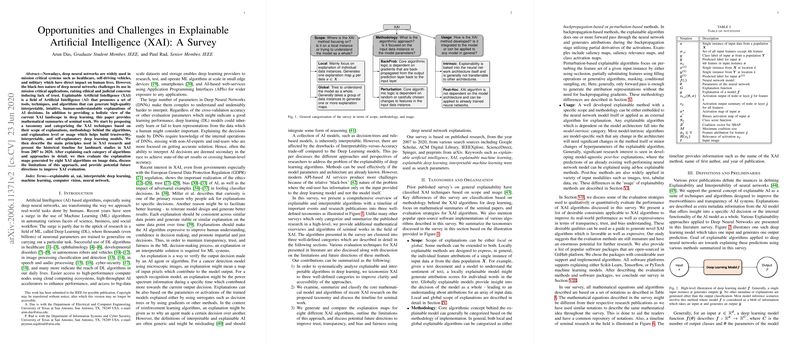Overview of Explainable Artificial Intelligence (XAI): A Survey
The paper by Das and Rad provides a comprehensive evaluation of the opportunities and challenges within the field of Explainable Artificial Intelligence (XAI). As AI systems are increasingly integrated into mission-critical applications, such as healthcare and autonomous vehicles, the black-box nature of deep learning models raises ethical and judicial concerns. This survey aims to address these concerns by dissecting the current landscape of XAI in deep learning.
Taxonomy of XAI Techniques
The paper proposes a taxonomy to categorize XAI techniques based on three dimensions: the scope of explanations, the methodology employed, and the level of integration with models.
- Scope:
- Local Explanations: These focus on interpreting individual predictions. Techniques such as LIME and SHAP are exemplars, which employ perturbation and game-theoretic approaches to attribute feature importance.
- Global Explanations: These aim to provide insights into the model's behavior across the entire dataset. Global surrogate models and Concept Activation Vectors (CAVs) are highlighted for their ability to approximate complex models with interpretable ones.
- Methodology:
- Perturbation-Based: Explains model predictions by observing changes when input features are perturbed. Techniques include LIME, SHAP, and RISE.
- Backpropagation-Based: Utilizes gradients for explanation, focusing on how input features impact model predictions through derivatives. Saliency maps and Grad-CAM fall in this category.
- Usage Level:
- Model Intrinsic: Include built-in explanations within the model's architecture. Generalized Additive Models (GAMs) demonstrate this approach.
- Post-Hoc: Applied to trained models without modifying their structure. Methods such as DeepLift and LRP are post-hoc, often providing model-agnostic insights.
Evaluation of XAI Techniques
The paper discusses the significance of evaluating the effectiveness of XAI methods, emphasizing the necessity for explanations that are stable, consistent, and computionally feasible. Techniques like System Causability Scale (SCS) and Benchmarking Attribution Methods (BAM) are introduced to assess the quality and reliability of XAI outputs.
Implications and Future Directions
The survey underscores the critical role of XAI in fostering transparency, trust, and fairness within AI systems. It suggests the need for standardized benchmarks to evaluate XAI methods and highlights the potential for further research in developing robust, scalable solutions.
While the current state of XAI offers a promising toolkit, the authors highlight challenges, such as susceptibility to adversarial attacks and the limitations of visualization techniques. Building upon these insights, future work should focus on improving human interpretability and integrating ethical considerations into model design.
Conclusion
This survey by Das and Rad is a significant contribution to understanding the complex landscape of XAI. It not only categorizes existing methodologies but also sets the stage for future innovations in crafting interpretable and trustworthy AI systems. As AI's role in societal applications grows, the advancement of XAI will be integral to ensuring ethical and effective integration into various domains.
